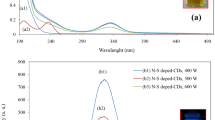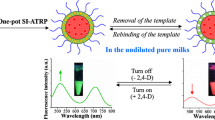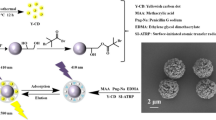Abstract
A thermal-sensitive molecularly imprinted optosensing probe based on fluorescent advanced glycation end products (AGEs) was prepared by one-pot hydrothermal synthesis. Carbon dots (CDs) derived from fluorescent AGEs were used as the luminous centers, while molecularly imprinted polymers (MIPs) were wrapped outside of the CDs to form specific target recognition sites to highly selectively adsorb the intermediate product of AGEs of 3-deoxyglucosone (3-DG). Thermosensitive N-isopropylacrylamide (NIPAM) was combined with acrylamide (AM) as co-functional monomers, and ethylene glycol dimethacrylate (EGDMA) was chosen as a cross-linker for targeting identification and detection of 3-DG. Under optimal conditions, the fluorescence of MIPs could be gradually quenched with the adsorption of 3-DG on the surface of MIPs in the linear range of 1–160 μg/L, and the detection limit was 0.31 μg/L. The spiked recoveries of MIPs ranged from 82.97 to 109.94% in two milk samples, and the relative standard deviations were all less than 1.8%. In addition, the inhibition rate for non-fluorescent AGEs of pyrraline (PRL) was 23% by adsorbing 3-DG in the simulated milk system of casein and d-glucose, indicating that temperature-responsive MIPs not only could detect the dicarbonyl compound 3-DG quickly and sensitively, but also had an excellent inhibitory effect on AGEs.
Graphical abstract






Similar content being viewed by others
References
Zhao W, Cai P, Zhang N, Wu T, Sun A, Jia G. Inhibitory effects of polyphenols from black chokeberry on advanced glycation end-products (AGEs) formation. Food Chem. 2022;392: 133295.
Chen Y, Tang S, Chen Y, Zhang R, Zhou M, Wang C, Feng N, Wu Q. Structure-activity relationship of procyanidins on advanced glycation end products formation and corresponding mechanisms. Food Chem. 2019;272:679–87.
van Dongen KCW, Kappetein L, Miro Estruch I, Belzer C, Beekmann K, Rietjens IMCM. Differences in kinetics and dynamics of endogenous versus exogenous advanced glycation end products (AGEs) and their precursors. Food Chem Toxicol. 2022;164: 112987.
Chen JH, Lin X, Bu C, Zhang X. Role of advanced glycation end products in mobility and considerations in possible dietary and nutritional intervention strategies. Nutr Metab (Lond). 2018;15:72.
Yuan X, He J, Su H, Liu H, Sun B. Magnetically controlled nanorobots based on red emissive peptide dots and artificial antibodies for specific recognition and smart scavenging of Nε-(carboxymethyl)lysine in dairy products. J Agr Food Chem. 2023;71(12):4970–81.
Uribarri J, Woodruff S, Goodman S, Cai W, Chen X, Pyzik R, Yong A, Striker GE, Vlassara H. Advanced glycation end products in foods and a practical guide to their reduction in the diet. J Am Diet Assoc. 2010;110(6):911-16.e12.
Yuan X, Meng C, Liu H, Sun B. Magnetically driven nanorobots based on peptides nanodots with tunable photoluminescence for rapid scavenging reactive α-dicarbonyl species and effective blocking of advanced glycation end products. Food Chem. 2023;422: 136252.
Liu H, Mu L, Chen X, Wang J, Wang S, Sun B. Core-shell metal-organic frameworks/molecularly imprinted nanoparticles as absorbents for the detection of pyrraline in milk and milk powder. J Agric Food Chem. 2017;65(4):986–92.
Liu H, Ni T, Mu L, Zhang D, Wang J, Wang S, Sun B. Sensitive detection of pyrraline with a molecularly imprinted sensor based on metal-organic frameworks and quantum dots. Sens Actuators B Chem. 2018;256:1038–44.
Singh R, Barden A, Mori T, Beilin L. Advanced glycation end-products: a review. Diabetologia. 2001;44(2):129–46.
Ayerdurai V, Garcia-Cruz A, Piechowska J, Cieplak M, Borowicz P, Noworyta KR, Spolnik G, Danikiewicz W, Lisowski W, Pietrzyk-Le A, D’Souza F, Kutner W, Sharma PS. Selective impedimetric chemosensing of carcinogenic heterocyclic aromatic amine in pork by dsdna-mimicking molecularly imprinted polymer film-coated electrodes. J Agric Food Chem. 2021;69(48):14689–98.
Ma H, Yang M, Wang X, Yang B, Zhang F, Zhang F, Li Y, Liu T, He M, Wang Q. Sulfonamide-selective ambient mass spectrometry ion source obtained by modification of an iron sheet with a hydrophilic molecularly imprinted polymer. J Agric Food Chem. 2021;69(50):15425–33.
Wang S, Shao R, Li W, Li X, Sun J, Jiao S, Dai S, Dou M, Xu R, Li Q, Li J. Three-dimensional ordered macroporous magnetic inverse photonic crystal microsphere-based molecularly imprinted polymer for selective capture of aflatoxin b(1). ACS Appl Mater Interfaces. 2022;14(16):18845–53.
Fang L, Jia M, Zhao H, Kang L, Shi L, Zhou L, Kong W. Molecularly imprinted polymer-based optical sensors for pesticides in foods: recent advances and future trends. Trends Food Sci Tech. 2021;116:387–404.
Wu H, Lin G, Liu C, Chu S, Mo C, Liu X. Progress and challenges in molecularly imprinted polymers for adsorption of heavy metal ions from wastewater. Trends Environ Anal. 2022;36: e00178.
Li Z, Liu J, Liu J, Wang Z, Wang J. Determination of sulfonamides in meat with dummy-template molecularly imprinted polymer-based chemiluminescence sensor. Anal Bioanal Chem. 2019;411(14):3179–89.
Bai X, Zhang B, Liu M, Hu X, Fang G, Wang S. Molecularly imprinted electrochemical sensor based on polypyrrole/dopamine@graphene incorporated with surface molecularly imprinted polymers thin film for recognition of olaquindox. Bioelectrochemistry. 2020;132: 107398.
Biyana Regasa M, Nyokong T. Synergistic recognition and electrochemical sensing of 17β-estradiol using ordered molecularly imprinted polymer-graphene oxide-silver nanoparticles composite films. J Electroanal Chem. 2022;922: 116713.
Wang F, Ling B, Li Q, Abouhany R. Dual roles of 3-aminopropyltriethoxysilane in preparing molecularly imprinted silica particles for specific recognition of target molecules. RSC Adv. 2020;10(34):20368–73.
Sullivan MV, Henderson A, Hand RA, Turner NW. A molecularly imprinted polymer nanoparticle-based surface plasmon resonance sensor platform for antibiotic detection in river water and milk. Anal Bioanal Chem. 2022;414(12):3687–96.
Li L, Lu Y, Bie Z, Chen HY, Liu Z. Photolithographic boronate affinity molecular imprinting: a general and facile approach for glycoprotein imprinting. Angew Chem Int Ed Engl. 2013;52(29):7451–4.
Li S, Yang K, Deng N, Min Y, Liu L, Zhang L, Zhang Y. Thermoresponsive epitope surface-imprinted nanoparticles for specific capture and release of target protein from human plasma. ACS Appl Mater Interfaces. 2016;8(9):5747–51.
Yoshimatsu K, Lesel BK, Yonamine Y, Beierle JM, Hoshino Y, Shea KJ. Temperature-responsive “catch and release” of proteins by using multifunctional polymer-based nanoparticles. Angew Chem Int Ed Engl. 2012;51(10):2405–8.
Zhang W, Liu W, Li P, Xiao H, Wang H, Tang B. A fluorescence nanosensor for glycoproteins with activity based on the molecularly imprinted spatial structure of the target and boronate affinity. Angew Chem Int Ed Engl. 2014;53(46):12489–93.
Cui Y, He Z, Xu Y, Su Y, Ding L, Li Y. Fabrication of molecularly imprinted polymers with tunable adsorption capability based on solvent-responsive cross-linker. Chem Eng J. 2021;405: 126608.
Xiong H, Fan Y, Mao X, Guo L, Yan A, Guo X, WanY, Wan H. Thermosensitive and magnetic molecularly imprinted polymers for selective recognition and extraction of aristolochic acid i. Food Chem. 2022;372:131250.
Xiong H, Guo L, Mao X, Tan T, Wan H, Wan Y. A magnetic hydrophilic molecularly imprinted material with multiple stimuli-response properties for efficient recognition of bisphenol a in beverages. Food Chem. 2020;331: 127311.
Jiang C, Wang Q, Wang T. Thermoresponsive pnipaam-modified cotton fabric surfaces that switch between superhydrophilicity and superhydrophobicity. Appl Surf Sci. 2012;258(11):4888–92.
Lu F, Lin X, Wu Q, Zhou B, Lan R, Zhou S, Wu W. Observation of unusual thermoresponsive volume phase transition behavior of cubic poly(N-isopropylacrylamide) microgels. Acs Macro Lett. 2020;9(2):266–71.
Nakamura C, Yamamoto T, Manabe K, Nakamura T, Einaga Y, Shiratori S. Thermoresponsive, freezing-resistant smart windows with adjustable transition temperature made from hydroxypropyl cellulose and glycerol. Ind Eng Chem Res. 2019;58(16):6424–8.
Thara CR, Korah BK, Mathew S, John BK, Mathew B. Dual mode detection and sunlight-driven photocatalytic degradation of tetracycline with tailor-made n-doped carbon dots. Environ Res. 2023;216:114450.
Zhu X, Han L, Liu H, Sun B. A smartphone-based ratiometric fluorescent sensing system for on-site detection of pyrethroids by using blue-green dual-emission carbon dots. Food Chem. 2022;379: 132154.
Sk MP, Jaiswal A, Paul A, Ghosh SS, Chattopadhyay A. Presence of amorphous carbon nanoparticles in food caramels. Sci Rep. 2012;2:383.
Li D, Na X, Wang H, Xie Y, Cong S, Song Y, Xu X, Zhu BW, Tan M. Fluorescent carbon dots derived from maillard reaction products: their properties, biodistribution, cytotoxicity, and antioxidant activity. J Agric Food Chem. 2018;66(6):1569–75.
Wang T, Chen C, Wang C, Tan YZ, Liao W. Multicolor functional carbon dots via one-step refluxing synthesis. ACS Sensors. 2017;2(3):354–63.
Bohlooli M, Ghaffari-Moghaddam M, Khajeh M, Aghashiri Z, Sheibani N, Moosavi-Movahedi AA. Acetoacetate promotes the formation of fluorescent advanced glycation end products (AGEs). J Biomol Struct Dyn. 2016;34(12):2658–66.
Zhang Y, Zhu X, Li M, Liu H, Sun B. Temperature-responsive covalent organic framework-encapsulated carbon dot-based sensing platform for pyrethroid detection via fluorescence response and smartphone readout. J Agr Food Chem. 2022;70(20):6059–71.
Zhu X, Zhang Y, Han L, Liu H, Sun B. Quantum confined peptide assemblies in a visual photoluminescent hydrogel platform and smartphone-assisted sample-to-answer analyzer for detecting trace pyrethroids. Biosens Bioelectron. 2022;210: 114265.
Guo T, Deng Q, Fang G, Yun Y, Hu Y, Wang S. A double responsive smart upconversion fluorescence sensing material for glycoprotein. Biosens Bioelectron. 2016;85:596–602.
Li X, Zhang B, Li W, Lei X, Fan X, Tian L, Zhang H, Zhang Q. Preparation and characterization of bovine serum albumin surface-imprinted thermosensitive magnetic polymer microsphere and its application for protein recognition. Biosens Bioelectron. 2014;51:261–7.
Zhang Y, Xu Y, Liu H, Sun B. Ultrahigh sensitivity nitrogen-doping carbon nanotubes-based metamaterial-free flexible terahertz sensing platform for insecticides detection. Food Chem. 2022;394: 133467.
Zhao Y, Zhang Y, Liu H, Sun B. A visual chiroptical system with chiral assembly graphene quantum dots for d-phenylalanine detection. Anal Bioanal Chem. 2022;414(17):4885–96.
Funding
This research was funded by the National Natural Science Foundation of China (No.32072335), and the Cultivation Project of Double First-Class Disciplines of Food Science and Engineering, Beijing Technology & Business University (BTBU).
Author information
Authors and Affiliations
Contributions
The manuscript was written through contributions of all authors. All authors have given approval to the final version of the manuscript.
Corresponding author
Ethics declarations
Conflict of interest
The authors declare no competing interests.
Additional information
Publisher's note
Springer Nature remains neutral with regard to jurisdictional claims in published maps and institutional affiliations.
Supplementary Information
Below is the link to the electronic supplementary material.
Rights and permissions
Springer Nature or its licensor (e.g. a society or other partner) holds exclusive rights to this article under a publishing agreement with the author(s) or other rightsholder(s); author self-archiving of the accepted manuscript version of this article is solely governed by the terms of such publishing agreement and applicable law.
About this article
Cite this article
He, J., Xie, C., Meng, C. et al. Molecularly imprinted thermosensitive probe based on fluorescent advanced glycation end products to detect α-dicarbonyl compounds and inhibit pyrraline formation. Anal Bioanal Chem 415, 5011–5021 (2023). https://doi.org/10.1007/s00216-023-04787-4
Received:
Revised:
Accepted:
Published:
Issue Date:
DOI: https://doi.org/10.1007/s00216-023-04787-4




